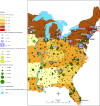Monitoring Sub-Saharan African physician migration and recruitment post-adoption of the WHO code of practice: temporal and geographic patterns in the United States
- PMID: 25875010
- PMCID: PMC4395332
- DOI: 10.1371/journal.pone.0124734
Monitoring Sub-Saharan African physician migration and recruitment post-adoption of the WHO code of practice: temporal and geographic patterns in the United States
Abstract
Data monitoring is a key recommendation of the WHO Global Code of Practice on the International Recruitment of Health Personnel, a global framework adopted in May 2010 to address health workforce retention in resource-limited countries and the ethics of international migration. Using data on African-born and African-educated physicians in the 2013 American Medical Association Physician Masterfile (AMA Masterfile), we monitored Sub-Saharan African (SSA) physician recruitment into the physician workforce of the United States (US) post-adoption of the WHO Code of Practice. From the observed data, we projected to 2015 with linear regression, and we mapped migrant physicians' locations using GPS Visualizer and ArcGIS. The 2013 AMA Masterfile identified 11,787 active SSA-origin physicians, representing barely 1.3% (11,787/940,456) of the 2013 US physician workforce, but exceeding the total number of physicians reported by WHO in 34 SSA countries (N = 11,519). We estimated that 15.7% (1,849/11,787) entered the US physician workforce after the Code of Practice was adopted. Compared to pre-Code estimates from 2002 (N = 7,830) and 2010 (N = 9,938), the annual admission rate of SSA émigrés into the US physician workforce is increasing. This increase is due in large part to the growing number of SSA-born physicians attending medical schools outside SSA, representing a trend towards younger migrants. Projection estimates suggest that there will be 12,846 SSA migrant physicians in the US physician workforce in 2015, and over 2,900 of them will be post-Code recruits. Most SSA migrant physicians are locating to large urban US areas where physician densities are already the highest. The Code of Practice has not slowed the SSA-to-US physician migration. To stem the physician "brain drain", it is essential to incentivize professional practice in SSA and diminish the appeal of US migration with bolder interventions targeting primarily early-career (age ≤ 35) SSA physicians.
Conflict of interest statement
Figures




References
-
- The Recife political declaration on human resources for health: renewed commitments towards universal health coverage. Third Global Forum on Human Resources for Health; 2013 Nov 10–13; Recife, Brazil. Available: http://www.who.int/workforcealliance/forum/2013/recife_declaration_17nov.... Accessed 2015 Mar 24.
-
- Global Health Workforce Alliance; World Health Organization. A universal truth: no health without a workforce Geneva: WHO; 2013. Available: http://www.who.int/workforcealliance/knowledge/resources/GHWA_AUniversal.... Accessed 2015 Mar 24.
-
- International Monetary Fund. Factsheet: debt relief under the heavily indebted poor countries (HIPC) initiatives. Available: http://www.imf.org/external/np/exr/facts/pdf/hipc.pdf. Accessed 2015 Mar 24.
-
- Hagopian A, Thompson MJ, Fordyce M, Johnson KE, Hart GL. The migration of physicians from sub-Saharan Africa to the United States of America: measures of the African brain drain. Hum Resour Health. 2004; 2:17 Available: http://www.human-resources-health.com/content/2/1/17. - PMC - PubMed
-
- Dumont JC, Zurn P. Immigrant health workers in OECD countries in the broader context of highly skilled migration. Int Migr Outlook. 2007; 162–228.
Publication types
MeSH terms
Grants and funding
LinkOut - more resources
Full Text Sources
Other Literature Sources
Research Materials

